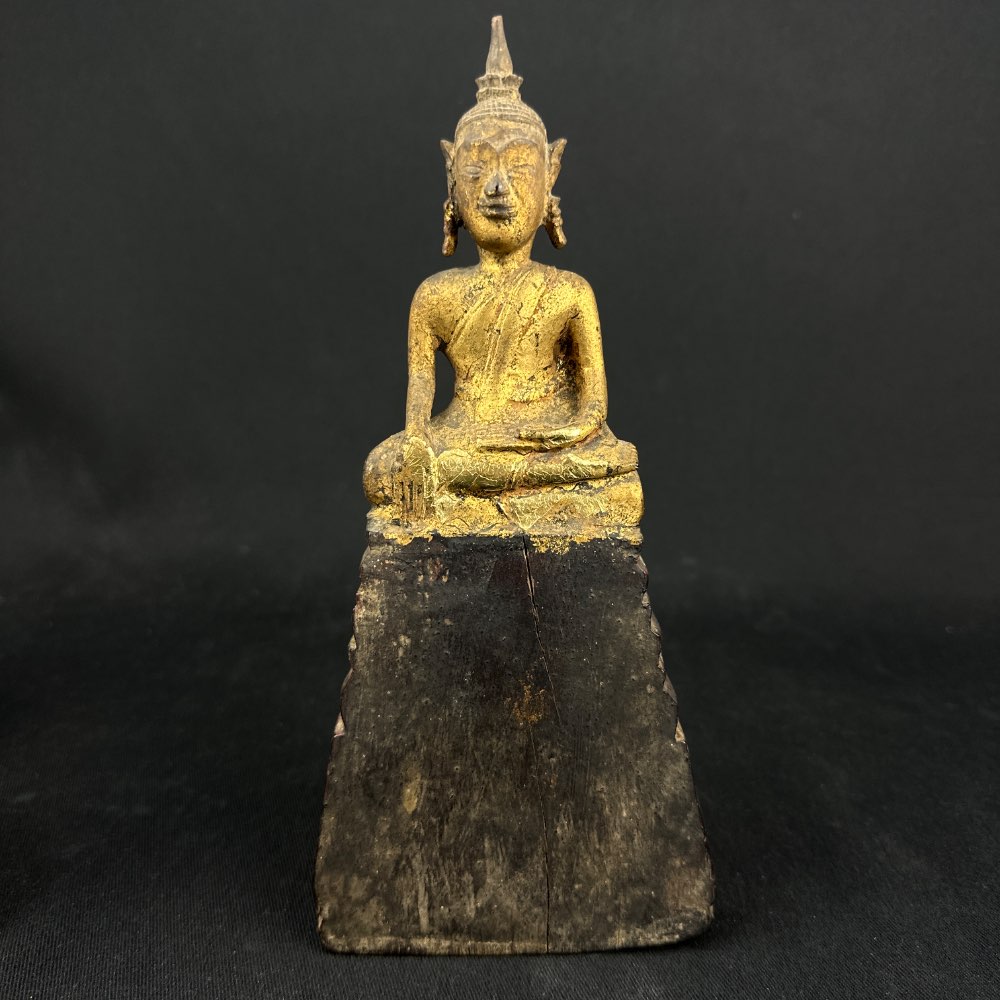












Thai Ayutthaya wooden Buddha, 18th century
Thai Ayutthaya wooden Buddha, 18th century
- Country: Thailand
- Period: 18th century
- Culture: Ayutthaya
- Material: wood with gold leaf (partly recent) and little red pigments
- Size: 21.8 x 9.8 cm
- Buddha's are sitting in the Bhumisparsha Mudra.
- Buddha comes out of an old Dutch collection.
The old city of Ayutthaya in Thailand stands as a testament to a bygone era, once a majestic capital and a thriving hub of commerce, culture, and spirituality. Founded in 1350, it flourished as the center of the Ayutthaya Kingdom for over four centuries, until its tragic downfall in 1767.
In its prime, Ayutthaya was a city of grandeur, exuding opulence and sophistication. The city's strategic location along the Chao Phraya River facilitated maritime trade, attracting merchants from distant lands and fostering a cosmopolitan atmosphere. Vessels carrying silks, spices, porcelain, and other exotic goods docked at its bustling ports, enriching the city with a tapestry of cultures.
The architectural marvels of Ayutthaya included magnificent temples, elaborate palaces, and towering stupas adorned with intricate designs and gilded ornaments. These structures, showcasing the ingenuity of Thai craftsmanship, reflected the kingdom's religious devotion, artistic prowess, and royal splendor.
The city's diverse population comprised locals, traders, diplomats, and settlers from neighboring regions and distant continents. This melting pot of cultures infused Ayutthaya with a vibrant tapestry of languages, traditions, and beliefs, creating a rich social fabric that resonated through its streets and markets.
The spiritual heart of Ayutthaya lay in its temples. Wat Mahathat, with its iconic Buddha head entwined in the roots of a banyan tree, symbolized the intertwining of nature and spirituality. Wat Chaiwatthanaram, an architectural masterpiece, stood as a testament to the kingdom's devotion to Buddhism.
However, the city's prosperity was not immune to the ravages of time and conflict. In 1767, Ayutthaya fell victim to a devastating invasion by the Burmese army. The once-majestic city witnessed widespread destruction, its temples and palaces pillaged, its treasures looted, and its people scattered.
The ruins of old Ayutthaya, now a UNESCO World Heritage Site, silently narrate the tales of its glorious past. Visitors wandering amidst the weathered remnants of temples and crumbling walls can almost hear echoes of a once-thriving metropolis. The haunting beauty of these ruins serves as a poignant reminder of the city's resilience and enduring spirit.
Today, Ayutthaya stands as a symbol of historical significance, drawing tourists and scholars alike to explore its ancient ruins and unravel the mysteries of its past. The remnants of this once-great city continue to inspire awe, inviting visitors to delve into a captivating chapter of Thai history and cherish the legacy of old Ayutthaya.
______________________________________________________________________________________________
The image of Buddha sitting on a lotus in the Bhumisparsha Mudra is one of the most iconic and spiritually significant depictions in Buddhist art and iconography, rich with symbolism reflecting profound philosophical and spiritual meanings. The lotus flower in this imagery represents purity, spiritual enlightenment, and resilience. It grows in muddy water, yet emerges pristine and beautiful, symbolizing the ability to rise above defilements and suffering. The lotus is often associated with the purification of the body, speech, and mind. Seeing the Buddha seated on a fully bloomed lotus signifies his awakened state and the realization of Nirvana.
The Buddha is typically shown in a cross-legged position (Padmasana), which represents a stable and grounded meditative state. His posture conveys tranquility, inner peace, and unwavering focus, symbolizing the Buddha’s deep meditative absorption.
The Bhumisparsha Mudra, or "Earth Touching Gesture," is performed by the Buddha sitting with his right hand reaching down to touch the ground, while his left hand rests on his lap, palm facing upward. This mudra symbolizes the moment of the Buddha's enlightenment under the Bodhi tree, where he called upon the Earth to witness his attainment of enlightenment. According to Buddhist tradition, before achieving enlightenment, the Buddha (then Siddhartha Gautama) was confronted by Mara, the personification of temptation and illusion. To dispel Mara's doubts and claim his right to enlightenment, Siddhartha reached down and touched the Earth with his right hand, calling upon it to bear witness to his countless lifetimes of virtuous actions. The Earth responded, quelling Mara and his forces, thereby affirming the Buddha's resolve and purity. The Bhumisparsha Mudra symbolizes unshakable faith, determination, and the Buddha’s victory over temptation and distractions. It represents the moment when Siddhartha transcended worldly attachments and achieved enlightenment, becoming the Buddha. The gesture also emphasizes the interconnectedness of all beings with the Earth, highlighting a deeper ecological and spiritual unity.
The combination of the Buddha on a lotus with the Bhumisparsha Mudra is a representation of transcendence over worldly suffering and the achievement of spiritual awakening. Artists often depict the Buddha with a serene and compassionate expression, emphasizing his state of bliss and wisdom. Surrounding elements like halos, bodhi leaves, or a calm background might be included to further enhance the sacred atmosphere.
This depiction of the Buddha is not just a piece of art but a visual meditation on the path to enlightenment, encouraging practitioners to stay grounded, pure, and determined in their spiritual journey.
Please send an e-mail via below form, WhatsApp or call to order or get more information about this object.
We can communicate in English, Deutsch and Nederlands!
